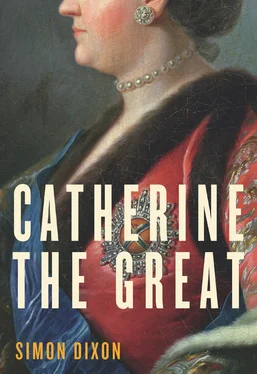Stop they did, but only to launch a disastrous firework. The first rockets flew straight into the main marquee, causing pandemonium among the imperial party and a stampede of the horses waiting patiently by the nearby carriages. 59
The main reason for visiting Kiev was to pay tribute to the cradle of Orthodoxy in the empire, for it was there that Prince Vladimir had accepted the Christian faith in 988. At the Monastery of the Caves, the pious empress was in her element. Though it would soon be possible, with the aid of a telescope, to see back to Kozelets from the top of the Baroque bell tower which she commissioned, the monastery’s real ‘sights’ lay within its own walls, in the catacombs and in the ancient Cathedral of the Dormition, where the relics of the great men of Kievan Rus were objects of open veneration (the head of Vladimir himself had been returned to the monastery in 1634). 60Catherine and her fiancé were forbidden entry to the catacombs in case they caught a chill, but she was much taken by the cathedral. ‘I had never been more struck in my life,’ she recalled in 1771, ‘than I was by the extreme magnificence of that church, where all the icons were covered in gold, silver and jewels. The church itself is spacious and built in the Gothic style of architecture that gives churches a much more majestic appearance than the current ones, where the size and transparency of the windows makes them indistinguishable from a ballroom or a [winter]—garden.’ 61
Back in Moscow for Elizabeth’s name day on 5 September, the Court launched into its customary autumn round of celebrations. Although Catherine took dancing lessons with the ballet master Jean-Baptiste Landé, nothing in her experience had prepared her for the cross-dressing balls that so delighted the empress. Elizabeth enjoyed showing off her excellent legs, but no one else took much pleasure from these so-called metamorphoses, at which the men were forced to stumble about the dance floor in huge hooped skirts. 62They were happier watching the French comedies and German dramas staged at the 5000-seat opera house built near the Golovin Palace for Elizabeth’s coronation in 1742. 63No less important to the life of the Court were its ‘theatres of piety’ in which the imperial family celebrated the major autumn feasts in the Orthodox calendar: the Nativity of the Mother of God on 8 September, the Exaltation of the Honourable and Life-Giving Cross on 14 September, and the Presentation of the Mother of God in the Temple on 21 November. 64Since the reign of Empress Anna, this last had been appropriated as the annual celebration of the Semënovsky Guards, so that the day which began with morning service culminated in a banquet and ball. 65Now there were two new fixtures to add to the list of secular festivities: the birthday of Johanna Elisabeth on 13 October and Catherine’s name day on 24 November. The following day was Elizabeth’s accession day—the most significant event in the Court calendar. 66The sickly Peter missed it all, being confined to bed by a chest infection in October and by chickenpox in November. Only when he seemed well enough to travel did the Court depart for St Petersburg. 67
Begun by Bartolomeo Rastrelli almost as soon as the Court returned from Moscow in January 1732, the Winter Palace he completed three years later was a highly embellished wooden structure incorporating the mansion which had once belonged to Peter the Great’s Admiral Apraksin. Empress Anna’s apartments struck visitors as ‘rather beautiful’ but ‘not very imperial’, because they were small and dark. 68Catherine and Peter were to think better of them during their brief occupation in the winter of 1746. This time, however, there was no room in the palace for either of them. While the lower floor was allocated to the small army of servants, actors, musicians and guards who accompanied the Court, the fun-loving Elizabeth was busy converting the upper rooms formerly occupied by her ladies-in-waiting to make space for a new merry-go-round, complete with expensively saddled wooden horses, to replace the dilapidated machine which stood outside the Summer Palace at the time of Catherine’s arrival in Russia. 69She and Johanna Elisabeth were lodged in a neighbouring house, where for the first time they had separate apartments on either side of the main staircase. Catherine had known of Elizabeth’s orders in advance. For her status-conscious mother, who had not, it came as a shock:
As soon as she saw this arrangement, she lost her temper, primo , because she thought that my apartment was laid out better than hers; secondo because hers was separated from mine by a shared room. In fact, we each had four rooms, two at the front and two overlooking the courtyard, and the rooms were of equal size, furnished in exactly the same blue and red fabric. 70
Squabbles about precedence were the last thing Catherine needed now that her fiancé had again been taken ill on the journey from Moscow. On learning of this new outbreak of pox, accompanied by a high fever, Elizabeth raced back from St Petersburg to join her nephew at Khotilov, a staging post between Novgorod and Tver where they had all celebrated her birthday on 18 December. Cancelling the New Year’s banquet, she stayed with him there until his recovery was assured, having cannon hauled specially from Tver to celebrate Epiphany, though Khotilov was too far from the river to conduct the customary blessing of the waters. 71By 26 January, empress and heir were safely back at Tsarskoye Selo. When they returned to the capital at the beginning of the following month, Catherine and her mother were taken straight to see Peter in the gloomy great hall of the Winter Palace. Johanna Elisabeth reported to her husband in Zerbst that Providence had granted the youth a miraculous recovery. Catherine remembered the scene differently:
All of his features were distorted; his face was still completely swollen, and one could see that he was bound to be permanently scarred. As his hair had been cut, he wore a huge wig that disfigured him all the more. He came up to me and asked if I found it difficult to recognise him. I stammered my congratulations on his recovery, but in truth he had become hideous. 72
At best this was a disconcerting turn of events. Yet there was nothing to be done about it now. While Lent kept her pock-marked fiancé out of the public eye between his birthday and hers, preparations for their marriage continued in earnest. 73
* * *
Since Princess Charlotte of Brunswick-Wolfenbüttel, the consort of Peter the Great’s ill-fated tsarevich, had been permitted to retain her Lutheran faith, Elizabeth instructed Count Santi, her Master of Ceremonies, to model Catherine’s wedding on the marriage of her own elder sister, Anna Petrovna, to Karl Friedrich of Holstein-Gottorp in 1725. On discovering that no records of that occasion survived, Santi had to work partly on oral tradition but above all on the basis of his own researches into the practice of rival European Courts. 74The plan he presented to the College of Foreign Affairs on 22 March 1745 left plenty for the empress to decide. The seating arrangements for Johanna Elisabeth and her brother, Prince Adolf Friedrich, were a particularly sensitive matter. Unbeknownst to either Catherine or her mother, her uncle had been invited to Russia by Chancellor Bestuzhev, and his arrival on 5 February, motivated by his desire to gain control over the affairs of the duchy of Holstein, caused nothing but trouble. 75(‘His appearance alone did him no favours,’ Catherine later commented. ‘He was very small and badly proportioned, not at all intelligent, hot tempered, and furthermore governed by his entourage.’) Santi, however, had already resolved to dispense with the idea of seating the bride under a canopy so that she could offer wine to the guests who came to congratulate her. Such an ‘Oriental’ custom might be appropriate for the ‘middling sort’, declared the haughty Piedmontese, who had spent the whole of Anna’s reign in exile in Siberia, but it was scarcely compatible with ‘good practice in the courts of Sovereigns’. 76
Читать дальше












